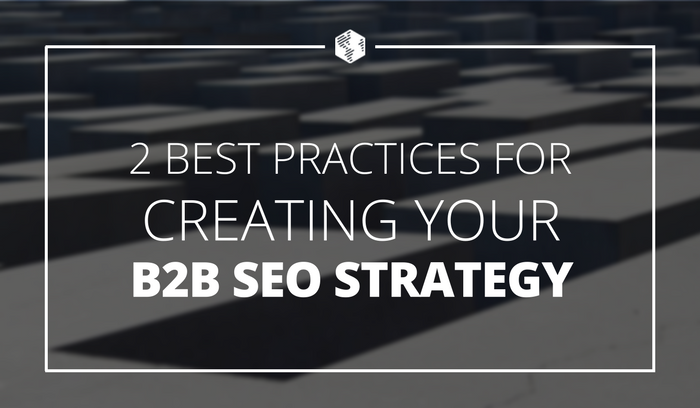Table Of Contents
Creating a strong Search Engine Optimization (SEO) strategy is crucial for businesses in any industry. However, there is no one-size-fits-all approach when it comes to optimizing your website and content. If you’re following generic advice when creating your SEO strategy, you may find that you’re not reaching the top of search results lists as efficiently as possible.
In the B2B world, SEO is done a bit differently. Due to the high stakes associated with most B2B purchases, the buying process is much different than in the B2C world. That means SEO also requires a distinct approach. From conducting the right kind of keyword research to identifying your customers’ needs, B2B businesses need to employ a particular set of techniques.
To improve your B2B business’ SEO strategy, let’s take a look at the two best practices you should follow!
Key Takeaways:
- B2B keywords should include more industry jargon and high-level terms than B2C keywords.
- Diversifying your content helps you reach many different B2B decision-makers.
- Knowing your customers’ unique needs can help you make better SEO decisions.
1. Choose Appropriate Keywords
Keywords are the backbone of any SEO strategy, since the ones you choose to target will determine the searches you appear in. Even if all your other SEO tactics are strong, you won’t be able to properly grow your customer base if you’re not targeting the right search words and phrases. This is true for both B2C and B2B businesses.
However, the keywords you’ll want to target aren’t quite the same for each type of business. If you’re selling B2B products or services, your target audience and ideal customer will typically have a closer connection to and better understanding of the industry you serve. This means that instead of searching for generic solutions to their problems, your B2B customers are more likely to use industry-specific terms and jargon within their searches.
Therefore, you’ll want to research very specific keywords to target as part of your B2B SEO strategy. Additionally, you’ll need to consider that different types of employees within your target company may be looking for your products or services. This means you’ll want to approach your keyword research from various angles.

To begin your keyword research, try coming up with a list of words or phrases that are relevant to the products you’re selling or the industry you serve. You’ll then want to conduct some research to find keywords that are popular among your target audience, but do not have a lot of competition. This can easily be done by using the Moz Keyword Research tool, as featured in the above example.
Once you know what your audience is searching for, you can use those words and phrases in your content and marketing. Just remember that researching and selecting keywords should be done on a regular basis, to ensure that your keywords remain accurate and relevant. You can also track your keyword rankings using the Clickx Dashboard, which is easy to use and allows you to view your progress and see which keywords could use more targeting in your content.
2. Mix Up Your Content Types
Thousands of new pieces of content are uploaded to the web each and every day. In order to appear in a search engine results list, therefore, you need to consistently contribute new pieces of high-quality material that will get noticed by search engine crawlers. Not only does new content give you an opportunity to target your keywords, but it also enables you to show search engines that you’re active (which is likely to boost your rankings).
However, when you’re uploading new content to your website, you’ll also want to create a mix of pieces that can attract attention from various audience members. If you’re only posting one type of content, you’re only targeting one specific interest or kind of user. This can quickly become boring for your customer base, pushing them to your competitors to find something new to engage with. In turn, this will hurt your search rankings.
Therefore, when creating your B2B content, you need to consider the various unique needs and preferences of your target audience. Since you may have many different decision-makers searching for your products or services, you need to create content that will appeal to each of them. Not only does this give your audience more information to engage with, but it ensures that you’re not leaving any major market ignored or forgotten about.
The simplest way to diversify your content is to offer various types, including blog posts, images, infographics, social media posts, and more. Videos are particularly effective, as seen in this example of content from Clickx:

In addition, you’ll want to think about how each new form of content can help you reach a new market. For example, creating videos and hosting them on YouTube enables you to appear in searches within that platform. Additionally, infographics can help you increase shares, driving more traffic to your website. You can also consider repurposing old content in new ways to attract attention while saving time and resources, such as by creating video versions or summaries of your blog posts.
Bonus: Listen to Your Customers’ Needs
When a search engine decides what content to share with its users, it is typically looking for pieces that have already made a strong impact on readers and viewers. In order to measure how successful a piece of content is, search engines will look at factors like the time spent on the page, total views, and shares. If you want to appear at the top of search engine results, you’ll need to create content that your audience finds valuable.
Creating content that your customers are looking for allows you to establish stronger connections with your target audience and get more attention online. When you’re providing value and assisting your customers in their purchasing decisions, you’re able to show search engines that you have something worth sharing. As the crawlers become familiar with your brand, website, and content, they’re more likely to push it up in the ranks.
Many companies try to guess what their audience is looking for, or simply create what they think their customers need. Unfortunately, this can be a waste of both time and money. If that content doesn’t make the hoped-for impact, it will instead get lost in the mass amounts of information available online. This is especially important for B2B businesses, since their customers tend to have highly specialized needs and interests.
To better understand what your target audience actually wants, engage with them on social media, read their comments and emails, and check out what they’re saying on forums. Don’t be afraid to have real discussions with your audience members. In fact, if you’re able to establish personal relationships with your customers, they will often become more loyal to your brand. Look for opportunities to ask questions and get feedback, and you’ll quickly learn what type of content your audience wants to see.
Conclusion
The right SEO strategies and techniques can help you make a better impression on your B2B customers. When you put your customers’ needs first and provide quality information and resources targeted to their interests, search engines will be more inclined to push your content to the top of their results lists. Using the Clickx Dashboard, you can also determine how to further improve your campaigns.
Let’s recap the three best practices you should follow to improve your B2B SEO strategy:
- Choose keywords appropriate to your business, industry, and offerings.
- Mix up your content types to appeal to new audience members.
- Listen closely to the information your audience is looking for.
How do you think these best practices will improve your SEO strategy? Let us know in the comments section below!
Image credit: Pexels.






